Nix Your Knotweed – Patience & Persistence Pay Off
Contributed by Suzanne Thompson
Knotweed – Falopia japonica, formerly Polygonum cuspidatum – is the most talked-about invasive plant in Connecticut, according to CT Invasive Plant Working Group (CIPWG) polls. And for good reason: this big-leafed, rapidly growing plant spreads through prolific seeds, plus roots and rhizomes can easily stretch over 20 feet and stem fragments as small as ½ inch can generate new plants. No wonder it seems to be taking over everywhere on the East Coast and eastern Canada.

Many other invasive plants exist in our state. But because Knotweed grows on river banks, above the waterline of marshes, along roadsides and other disturbed soils, we readily see it. The thick, reddish-tinged bamboo-like stems shoot up in spring, before most native plants do, and large green heart-shaped leaves start unfurling, shading out competition. By August, clumps of green loom 12 -15 feet tall, decked with racemes of little white flowers.
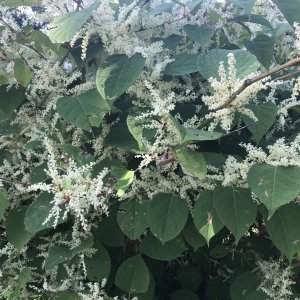
For ten years, professional organic gardener Petie Reed has told me about her method to control this encroacher – simply cut it back to the ground three times each summer, between May and mid-August. Dispose of the cuttings so they cannot resprout (see more about cuttings below.) Do this for three years – be persistent and patient – and you will see native plants, previously starved of sunlight, coming back. This method also is called carbohydrate deprivation, top growth is removed before the nutrients are translocated to the roots to fuel next year’s growth.
But I was always too busy, between work and driving kids to soccer and dance classes, to chop Knotweed. Until COVID hit in 2020: schools shut down, sports cancelled, people worked from home, gyms closed. I was going stir crazy. Then garden work was declared an essential activity!
So, we launched Nix the Knotweed – a volunteer information compaign, totally boot-strapped using free social media and a YouTube channel.
My equally bored former babysitter, stuck at home, was very adept at shooting and editing cell phone videos. We created a simple 2-page flyer, which you can download from the Old Lyme Conservation Commission page.
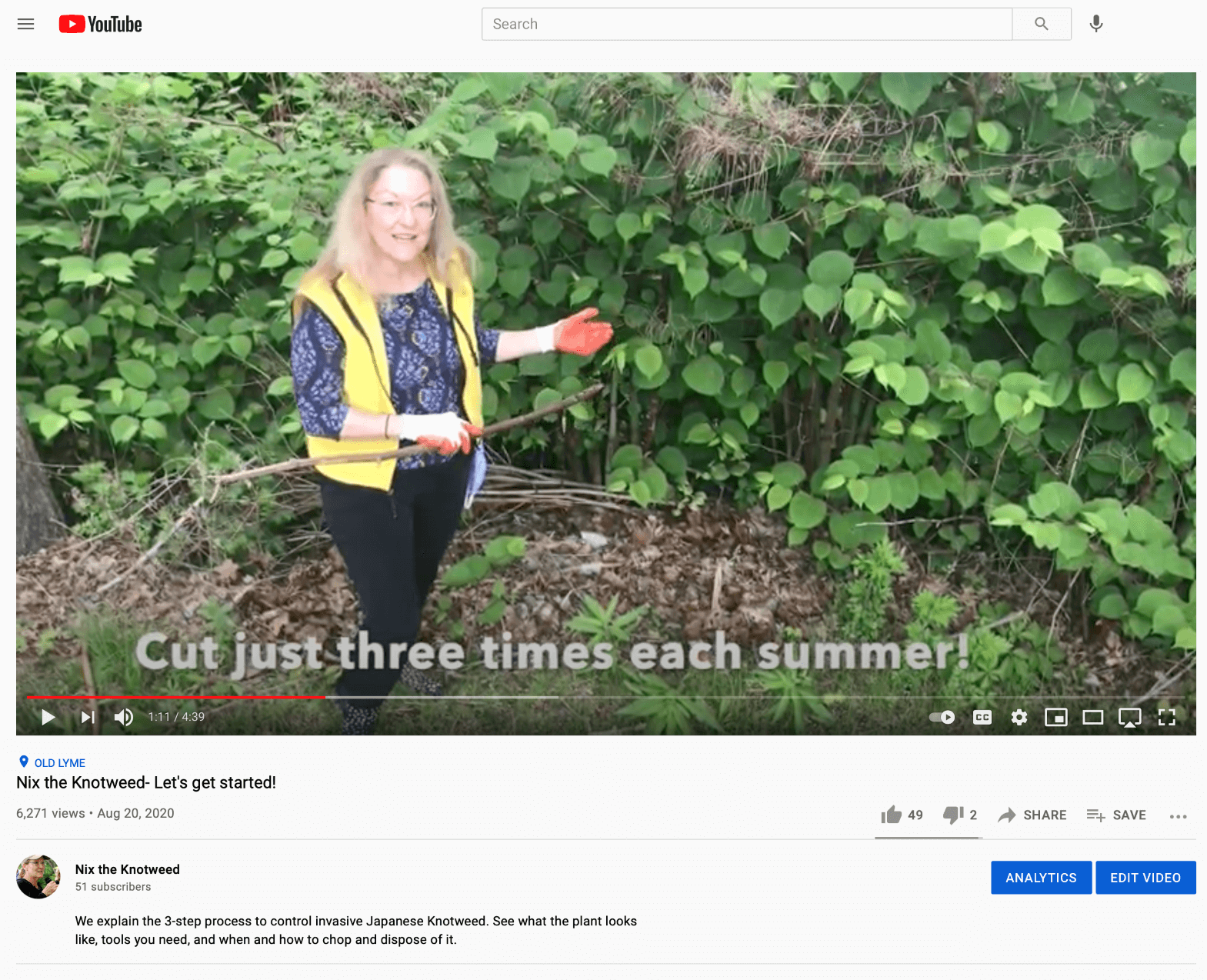
We started with two sites and encouraged volunteers to help: the marsh behind Old Lyme Town Hall parking lot and an overgrown slope on Lyme Art Association property. Our goal is to turn that space into a native plein air painting garden for the 100-year-old association.
Now in the second year, we see positive results at both sites, with many native grasses, wildflowers and weeds coming back. Other invasive species are showing up, too, so while we focus first on Knotweed, we rogue out bittersweet, barberry and other unwanted plants and seedlings. We also bag and incinerate seeds of invasive plants and unwanted weed species. However, we pay attention to which native weeds are transitional plants in ecosystem succession and important pollinators.
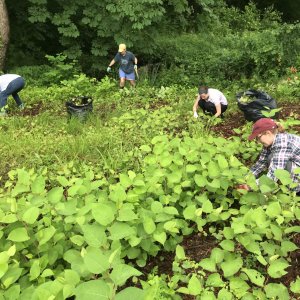
The goal is to control the Knotweed first, observe what suppressed native plants naturally come back. Don’t replant native plugs in the first year; there will be significant regrowth the second year, which means you will trample the area to chop. It is okay to toss down grass seed or seed heads from neighboring native plants in the first fall. Just don’t expect their young sprouts to be an effective barrier against Knotweed regrowth in the second year.
This pragmatic, persistent method requires a different philosophical mindset than spraying plants with chemical herbicides. Seeing aggressive Knotweed resprouting is frustrating. But it also is part of carbohydrate deprivation. Once apical dominance of the main stem is broken, the plant will put out multiple, skinnier stems. Cut those off. And in second and third years, the first primary shoots of the spring also will be weakened and smaller.
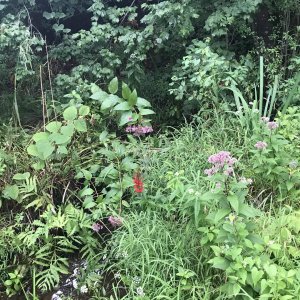
What to do with live Knotweed cuttings?
Chopping down knotweed is the fun part. Seriously. Especially in social groups. It’s exercise, outdoors, you feel productive! And it is gratifying to see and learn about the native plants coming back.
The more complicated challenge is how to dispose of viable Knotweed plant parts so they do not reproduce. DO NOT compost any live invasive plant parts or toss them into the woods or town woodpile. Invasive plant propagules (any part that can reproduce) can be bagged and tossed into our municipal trash. For decades, CT has incinerated this waste. However, with MIRA (Materials Innovation and Recycling Authority) incinerator in Hartford scheduled to close in 2022, many towns have to look for other disposal options.
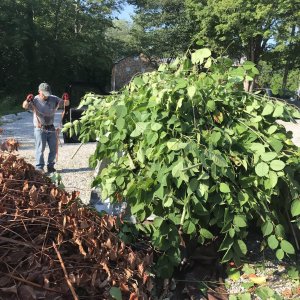
So, we are experimenting with various solarizing techniques: laying the live Knotweed cuttings between tarps or leaving bags, on concrete, to fully dry out. Once fully dry and dead, the cuttings can be composted. Some municipalities will allow controlled burns; please check with your town fire officials. We have heard various opinions and experiences feeding knotweed to goats; check with your veterinarian or an experienced goat herder before serving it.
Yes, Knotweed can be eaten by humans; in Japan it is a popular food, often pickled. However, harvest season for tender young shoots is short and early, before asparagus. Once pithy, the Knotweed is less palatable and more work to prepare as an ingredient. There is more than enough unwanted Knotweed growing than we could possibly eat, or want to.

Where do we go from here?
Volunteers at Whalebone Cove and Lyme Land Trust, Old Lyme Land Trust, East Lyme’s Veterans Memorial Field, and on Fishers Island have launched Nix the Knotweed campaigns. We plan to hold a fall Zoom session to compare results and tips, and we hope to expand to more communities next year. Please Like/Follow NixtheKnotweed Facebook and Nix the Knotweed YouTube Channels. Join us in being patient & persistent in Nixing the Knotweed.
Contributed by Suzanne Thompson
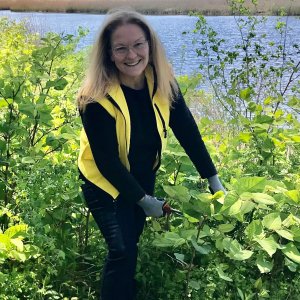
Suzanne Thompson, a professional garden writer and environmental activist with Save the Sound, earned her BS degrees in Urban Horticulture and Journalism at Kansas State University. After a career that spanned from radio-TV to Capitol Hill, government agencies and life sciences corporations, she has returned to her roots of interviewing and writing about fellow gardeners. A 2014 CT Master Gardener, she is also a CT NOFA Accredited Organic Land Care Professional, and volunteers her time as co-leader of Pollinate Old Lyme! when she isn’t chopping knotweed. Email her at nixtheknotweed@gmail.com.





